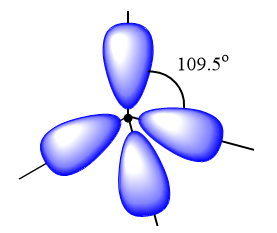Question
Question: What are \(sp\), \(s{p^2}\) and \(s{p^3}\) orbitals?...
What are sp, sp2 and sp3 orbitals?
Solution
The concept of intermixing of two or more atomic orbitals of different shape and nearly of same energy to generate the orbitals of same shape, equal energy and orientation as to minimize the repulsions between orbitals is known as hybridization.
Complete answer:
The reason to introduce the concept of hybridization was the failure of valence bond theory in certain aspects which are as follows:
1. Valencies of certain elements- The maximum number of covalent bonds which an atom is capable to form is equal to the number of unpaired electrons present in its valence shell. However, the valence bond theory failed to explain the covalent bonding in beryllium, boron and carbon.
2. The valence bond theory cannot explain shapes, geometries and bond angles in certain molecules like the tetrahedral shape of a methane molecule.
Thus, the concept of hybridization was introduced to overcome these limitations. The atomic orbitals formed by the result of hybridization are known as hybrid orbitals. Let’s now discuss the given hybrid orbitals.
sp hybrid orbitals: It is observed when one s and one p orbital of an atom mix to form two new similar orbitals. It forms linear molecules and the angle between the bond is 180o. Example: BeF2

sp2 hybrid orbitals: It is observed when one s and two p orbitals of an atom mix to three two new similar orbitals. It forms trigonal planar geometry and the angle between the bond is 120o. Example: C2H4

sp3 hybrid orbitals: It is observed when one s and three p orbital of an atom mix to form four new similar orbitals. It forms molecules with tetrahedral geometry and the angle between the bond is 109.5o. Example: CH4.

Note:
Remember that the hybrid orbitals are usually involved in the sigma bonds of polyatomic molecules whereas the pi bonds are generally formed by the overlap of unhybridized orbitals. It is important to note that the hybrid orbitals do not exist in an isolated atom.
